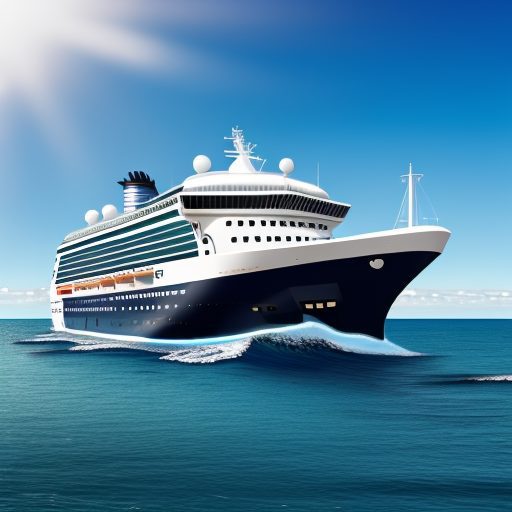Setting sail on a cruise ship promises a delightful journey filled with breathtaking ocean views, exciting ports of call, and luxurious relaxation. However, the tranquil seascape can quickly turn into a nightmare for those susceptible to feeling seasickness or motion sickness on cruise itineraries.
This unwelcome phenomenon has the power to cast a shadow over an otherwise splendid cruise vacation, leaving travelers feeling miserable and missing out on the joys of their voyage. In this article, we will delve into the world of motion sickness, exploring its causes, symptoms, and most importantly, how to prevent and manage it, ensuring your cruise ship holiday remains a memorable and enjoyable experience from start to finish.
Table of Contents
What is Seasickness on a Cruise?
Symptoms of Seasickness or Motion Sickness
What to do if You Get Seasick on a Cruise
How To Prevent Seasickness On A Cruise
Cruising Recommendations
Bon Voyage!

Seasickness or Motion Sickness
Seasickness, also known as motion sickness, is a condition that occurs when there is a disconnect between the sensory inputs that your body receives. It typically happens when your eyes perceive one motion, such as the motion of a ship or boat rocking on the water, while your inner ear, responsible for balance, senses a different motion or perceives a lack of movement.
This sensory conflict can lead to a range of symptoms, including nausea, vomiting, dizziness, cold sweats, and general discomfort. While seasickness is commonly associated with travel on water, it can also occur in other situations where there is a disparity between what you see and what your body feels, such as in cars, planes, or amusement park rides.
What are the Symptoms of Seasickness?
Seasickness, also known as motion sickness, can manifest with a variety of symptoms, which may vary in intensity from person to person. Common symptoms include:
1) Nausea: Feeling queasy or an upset stomach is a hallmark symptom of seasickness.
2) Vomiting: Many individuals experience vomiting or retching due to the body’s response to the conflicting sensory signals.
3) Dizziness: A sensation of spinning or unsteadiness can occur, making it difficult to maintain balance.
4) Cold Sweats: Experiencing clammy or sweaty skin, often accompanied by feelings of discomfort.
5) Pallor: The skin may become pale or slightly greenish due to the body’s response to the motion.
6) Fatigue: Feeling tired or weak as a result of the body’s efforts to cope with the sensory discrepancy.
7) Headache: Some individuals develop headaches or migraines as a consequence of motion sickness.
8) Salivation: Excessive salivation or increased saliva production can be a symptom.
9) Rapid Breathing: Breathing patterns may become irregular or faster than usual.
10) Loss of Appetite: A reduced desire to eat due to the discomfort caused by motion sickness.
These symptoms can collectively lead to an overall feeling of discomfort and can significantly impact the enjoyment of a cruise vacation or any other activity that involves motion.

What to do if You Experience Motion Sickness (sea sickness) on a Cruise
If someone experiences sea sickness or motion sickness while on a cruise, there are several steps they can take to alleviate their discomfort:
1) Find Fresh Air: Head to an outdoor deck or open area where you can feel the breeze and get fresh air. Staying in a well-ventilated space can help reduce the sensation of nausea.
2) Focus on the Horizon: Fixating on a distant, stationary point like the horizon can help recalibrate your senses and reduce the conflicting signals that cause motion sickness.
3) Stay Hydrated: Sip on clear fluids like water or ginger ale to stay hydrated. Avoid alcohol and caffeinated beverages, as they can exacerbate symptoms. Bring your own refillable water bottle with you everywhere.
4) Ginger: Ginger is known for its anti-nausea properties. Ginger candies, ginger tea, or ginger ale can help soothe an upset stomach.
5) Acupressure Bands: Special wristbands designed for motion sickness apply pressure to specific points on the wrist that may provide relief.
6) Medications: Over-the-counter medications or prescription medications such as antihistamines can help alleviate symptoms. Consult a healthcare professional before taking any medication to treat seasickness.
7) Stay Upright: Sit or stand in a stable position and avoid lying down, which can worsen the sensation of motion. Avoid sitting backwards if possible. You may feel seasick worse when you are facing the opposite direction on the pool deck than the cruise ship is traveling.
8) Distraction: Engaging in activities that take your mind off the motion, such as reading or listening to music, can help reduce symptoms.
9) Avoid Strong Odors: Strong smells, especially those associated with food, can worsen nausea. Opt for bland or neutral scents.
10) Rest: Sometimes, lying down with your eyes closed and taking deep breaths can help calm your body and reduce symptoms.
11) Seek Help – Visit guest services or the onboard medical center if you are experiencing multiple symptoms. Feeling motion sickness, stomach cramps from the ship moving is no fun. Sometimes it just takes a day or two to get your sea legs. However a medical professional onboard has likely dealt with others feeling seasick. They can recommend what might help your specific situation the best.

How to Prevent Seasickness on a Cruise
Preventing seasickness before or during a cruise involves a combination of preparation, lifestyle adjustments, and utilizing remedies to minimize the risk of experiencing discomfort. Here are some effective ways to prevent seasickness:
1) Choose the Right Cabin Location: When booking your cabin, opt for a midship location and lower deck. These areas experience less of the ship’s movement compared to cabins located at the front or back of the ship.
2) Check Weather and Itinerary: Research the weather conditions and expected sea conditions for your cruise route. Choose cruises during calmer seasons or in regions known for smoother waters. Calmer seas often are the best way to avoid seasickness. Avoid hurricane season (even though no cruise company will cruise in the same direction as a hurricane, it’s still a great preventative measure to avoid rough seas. The tip of South America is also known for rough waters. If you are prone to seasickness symptoms like most passengers can be in some form or another, it’s best to look at more destinations with calmer waters.
3) Medications: Consult your healthcare provider before the cruise to discuss over-the-counter or prescription medications for motion sickness. Antihistamines, scopolamine patches, and certain prescription medications can help prevent symptoms.
4) Acupressure Bands: Wristbands designed to apply pressure to specific points on your wrists can provide relief from motion sickness. These bands are available at pharmacies and can be worn before and during the cruise.
5) Ginger: Ginger is a natural remedy known for its anti-nausea properties. Consider consuming ginger candies, ginger tea, or ginger capsules before and during the cruise.
6) Stay Hydrated: Dehydration can worsen motion sickness symptoms. Drink plenty of water and clear fluids before and during the cruise. Staying hydrated is a great natural motion sickness medication most don’t even think about. This also helps avoid your stomach muscles from cramping, and will help you with other symptoms if you feel ill.
7) Eat Lightly: Avoid heavy, greasy, or spicy foods before and during the cruise. Opt for bland and plain food that is easily digestible. Greasy foods can make you feel sick, and avoiding them altogether for other plain food is a simple task.
8) Rest and Sleep: Ensure you are well-rested before the cruise. Fatigue can exacerbate motion sickness. During the cruise, take breaks to rest and relax if needed. Sometimes it can take cruisers up to three days days to kick the symptoms, so do your best to avoid alcohol intake and stay of the higher decks where the rocking motion can be felt more.
9) Stay Upright: When onboard your ship, sit or stand in a stable position and avoid lying down. Keeping an upright posture can help your body adjust to the ship’s motion. Pregnant women with back pain should still try and stay upright, even if sitting in bed. Staying hydrated as well will help get rid or reduce pregnancy cramps.
10) Focus on the Horizon: Fixate your gaze on a distant, stationary point such as the horizon. This can help recalibrate your senses and reduce motion sickness. If your inner ear senses some normal spatial orientation, you will start to feel better in your day to day life on these giant cruise ships.
11) Fresh Air: Spend time on open decks or in well-ventilated areas with fresh air. Avoid enclosed spaces and strong odors. Many travelers think staying in their cruise ship cabin is the solution, however modern cruise ships have plenty of space to walk around for those feeling queasy and trying to avoid motion sickness.
12) Mind Over Matter: Stay positive and keep your mind occupied with activities you enjoy, like reading, watching the scenery, or engaging in conversations.
13) Avoid Alcohol and Caffeine: Alcohol and caffeinated beverages can dehydrate your body and exacerbate motion sickness. Limit their consumption during the cruise.
14) Preventative Medication: If your healthcare provider recommends it, take motion sickness medications as directed before embarking on the cruise.
15) Practice Breathing Techniques: Deep, slow breathing can help relax your body and reduce feelings of nausea. This is especially important during rough seas or if it’s your first cruise and you didn’t bring any over the counter medication to alleviate seasickness.
16) Use Natural Remedies: Some people swear by green apples and peppermint tea being two of the best natural remedies. They can both be used as a seasickness remedy if you feel ill. Green apples and peppermint tea are often recommended for alleviating motion sickness due to their potential to ease nausea and aid digestion. These remedies are based on anecdotal evidence and traditional practices. Green apples contain natural compounds that might help soothe the stomach and reduce nausea, while peppermint tea has been known for its calming effect on the digestive system. Both options are considered relatively gentle and safe methods to provide some relief from the discomfort of motion sickness. However, it’s important to note that individual responses can vary, and these remedies might not work for everyone. If you’re prone to motion sickness, it’s a good idea to explore various approaches and find what works best for you.
Remember that prevention methods may vary from person to person, so it’s important to try different strategies to find what works best for you. If you’re concerned about seasickness, start implementing these prevention methods well before your cruise departure to give your body time to adjust and minimize the risk of discomfort.
Check out our other cruise articles:
Cruising Recommendations
If you are an individual who is prone to motion or seasickness, and have never cruised before, we recommend trying a shorter 3-5 day cruise to see how you fair. Going on a 7-10 day cruise for your first one, and being seasick most of the time would certainly be a downer of a vacation.
Fortunatley most cruise lines offer shorter 3-5 day cruises in calm waters. Try a short one from Miami to the Bahamas, and you will certainly know by the end of the cruise whether you are ready for more cruising adventures.

Bon Voyage
Understanding the intricacies of motion sickness and its impact on a cruise experience can greatly enhance your journey. The role of spacial orientation and the active compound found in remedies highlight the complex interplay between our senses and the vestibular system. By proactively employing techniques to combat seasickness, such as medications, acupressure bands, and lifestyle adjustments, you can ensure smoother sailing and a more enjoyable voyage.
Whether it’s preparing your body hours prior to departure or choosing a modern ship equipped with stabilization technology, the power to navigate the challenges of seasickness is within your grasp. So set sail with confidence, armed with the knowledge to enjoy every moment so you can have the best cruise vacation with some smooth sailing!


